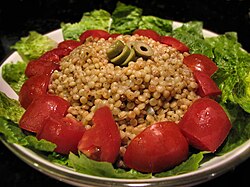Type a search term to find related articles by LIMS subject matter experts gathered from the most trusted and dynamic collaboration tools in the laboratory informatics industry.
 | |||||||
| Alternative names | Ptitim or P'titim | ||||||
|---|---|---|---|---|---|---|---|
| Type | Pasta | ||||||
| Course | Side dish | ||||||
| Place of origin | Israel | ||||||
| Created by | Osem | ||||||
| Main ingredients | Wheat | ||||||
| 200 kcal (837 kJ)[1] | |||||||
| |||||||
Ptitim (Hebrew: פְּתִיתִים, p'titím, lit. 'flakes', singular: פְּתִית, p'tít, lit. 'flake')[2] – sometimes called pearl couscous – is toasted pasta in tiny balls. Despite its name, it is not a type of couscous (Hebrew: קוּסְקוּס, kus'kus). The pearls are similar to the ones of Malta.

Ptitim was created in 1953,[3] during the austerity period in Israel.[4]
Israel's first prime minister, David Ben-Gurion, asked Eugen Proper, one of the founders of the Osem food company, to devise a wheat-based substitute for rice.[5] The company took up the challenge and developed ptitim, which is made of hard wheat flour and toasted in an oven. Ptitim was initially produced with a rice-shape, but after its success Osem also began to produce a ball-shaped variety inspired by couscous.[6]
Consequently, ptitim is sometimes called "Ben-Gurion rice".[7]
Ptitim is made by extruding dough through a round mold, before it is cut and toasted, giving it the uniform natural-grain-like shape[6] and its unique nutty flavor.[8] Unlike common types of pasta and couscous, ptitim was factory-made from the outset, and therefore is rarely seen home-made from scratch. The store-bought product is easy and quick to prepare.[9]
In Israel, ptitim is popular among children, who eat it plain, or mixed with fried onion and tomato paste.[5] Ptitim is now produced in ring, star, and heart shapes for added appeal.[7] Varieties made with whole wheat and spelt flour are also available for health-conscious consumers.[10][5] Ptitim has also been popularised in other countries,[7] and in the United States, it can be found on the menus of contemporary American chefs and in gourmet markets.[11]


Ptitim can be used in many different types of dishes, both hot and cold.[9] The grains retain their shape and texture even when reheated, and they do not clump together.[11] Commonly, ptitim is prepared with sautéed onions or garlic (vegetables, meat, chicken or sausage can also be added). The ptitim grains may be fried for a short time before adding water.[7] They can also be baked, go in soup, served in a pie, used for stuffing, or made as a risotto.[5] Ptitim may also be used in other dishes as a substitute for pasta or rice.[12] American chef Charlie Trotter has produced a number of recipes for ptitim-based gourmet dishes,[5] even as a dessert.[6]
Ptitim are very similar to the Ashkenazi Jewish farfel, which was brought to Israel by Ashkenazi Jews from Europe beginning in the 1800s, and the two are often substituted for each other.[13]
The round shape of ptitim is reminiscent of the forms of Levantine 'pearl' couscous that pre-date it, and which are known as moghrabieh in Jordan, Lebanon and Syria, or as maftoul in Palestinian cuisine.[14][4] While moghrabieh and maftoul are produced by rolling dough between the palms or fingers, ptitim are formed by extrusion through a die in the same process as many other pastas,[15] and the two are somewhat different in terms of taste and preparation.[3]
Ptitim are also similar to the Berber berkoukes (aka abazine) and the Sardinian fregula, but these, too, unlike ptitim, are rolled and coated products. Ptitim also resemble some products of the pastina family, in particular acini di pepe, orzo ("risoni") and stellini. However, unlike pastina, the ptitim grains are pre-baked/toasted[14] to give them their chewy texture and nutty flavor.[6]